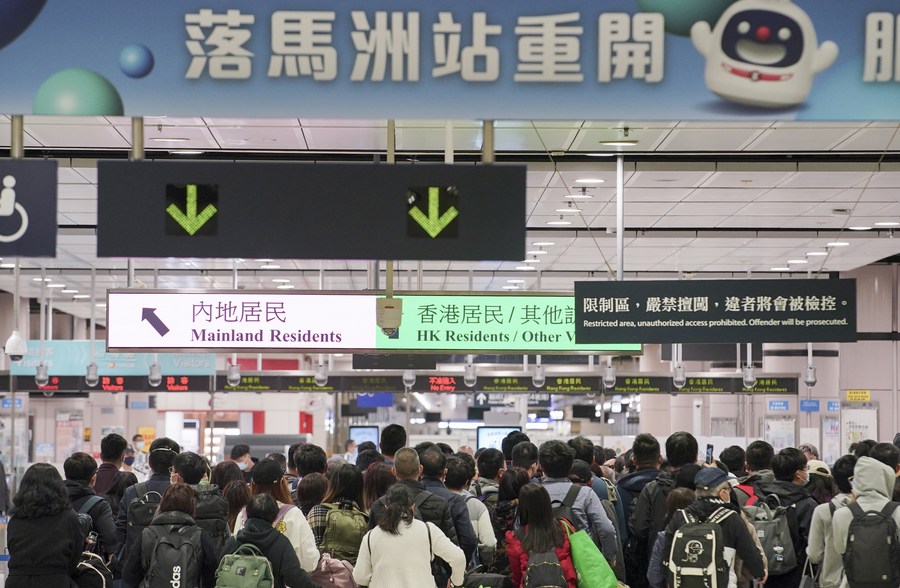Progressive, smooth reopening of mainland-Hong Kong border brings promising future

A traveler from Hong Kong poses for a photo outside the arrival hall of Shenzhen Bay control point in south China, Jan. 8, 2023. (Xinhua/Mao Siqian)
"This day has finally come! I'm so happy that I can go home now," said an inbound Hong Kong visitor at the Hong Kong-Zhuhai-Macao Bridge control point on Sunday, after the Hong Kong Special Administrative Region government announced that the first-phase resumption of normal personnel exchanges between the mainland and Hong Kong started on Jan. 8.
SHENZHEN/HONG KONG, Jan. 9 (Xinhua) -- In the early hours on Sunday, a shuttle bus carrying 27 Hong Kong passengers pulled out from the Hong Kong-Zhuhai-Macao Bridge Hong Kong Port. After around 40 minutes, the bus arrived at the Zhuhai Port of the bridge.
The first batch of inbound Hong Kong visitors crossed the control point and entered the mainland smoothly and safely.
"This day has finally come! I'm so happy that I can go home now!" Cheung Hoi Wah, an inbound Hong Kong visitor, said that everything went well when crossing the border.
Normal personnel exchanges between the mainland and Hong Kong started to resume progressively and orderly in phases as various control points linking the mainland and Hong Kong reopened on Sunday. This marked the first step of the resumption of normal travel between the two places after nearly three years.
China's Hong Kong Special Administrative Region (HKSAR) government earlier announced that the first-phase resumption started on Jan. 8, covering the Hong Kong International Airport, the Hong Kong-Zhuhai-Macao Bridge and the Shenzhen Bay Control Point that are in operation, as well as the reopened Hong Kong-Macao Ferry Terminal, China Ferry Terminal, Man Kam To Control Point and Lok Ma Chau Spur Line/Futian Control Point.

This aerial photo taken on Jan. 8, 2023, shows a shuttle bus from Hong Kong entering Zhuhai through the Hong Kong-Zhuhai-Macao Bridge in south China. (Xinhua/Liu Dawei)
At around 6 a.m., long queues were seen at Hong Kong's Lok Ma Chau Spur Line Control Point. Public announcements ran in a continuous loop in Mandarin, Cantonese and English to remind passengers to prepare their identity cards, booking confirmations for crossing the border and other documents in advance.
Including the Lok Ma Chau Spur Line Control Point, a daily quota of 50,000 at the three land control points was set in the first phase of resumption for Hong Kong residents heading to the mainland.
"I haven't celebrated the Chinese New Year at home for a long time. I took a long leave this time and my parents are very happy," Mr. Guo from Shanxi province, who was away from home for nearly two years, made bookings to return to the mainland with his girlfriend when he heard about the border reopening.

Travelers arrive at the Lok Ma Chau control point by Mass Transit Railway (MTR) in Hong Kong, south China, Jan. 8, 2023. (Xinhua/Lui Siu Wai)
At Futian Port in Shenzhen, red lanterns, welcome banners, and goody bags creating a warm and festive atmosphere were ready to receive inbound visitors.
At 6:36 a.m., on the second floor of the arrival hall of Futian Port, Hong Kong resident Mr. Chong successfully crossed the border control and became the first visitor entering the mainland through Futian Port on Sunday.
"I feel happy and lucky to be the first visitor. I'm going back to my hometown to celebrate the Chinese New Year," he said.
At around 7 a.m., more and more visitors entered the mainland. Most of them were carrying luggage and backpacks, and some were traveling with the elderly and kids.
"After three years of waiting, the border finally opened and we can travel freely," Hong Kong resident Mr. Yu, who returned to the mainland to visit relatives, said it took him only a few minutes to make an online booking two days ago, and the process of crossing the border went smoothly for only about 10 minutes.

Travelers from Hong Kong line up to enter the mainland at Futian control point in south China, Jan. 8, 2023. (Xinhua/Liang Xu)
Edward Leung, a member of the Legislative Council of the HKSAR, and his team set off for Dongguan and other places in the mainland through Futian Port. They were on an exchange trip to study the entrepreneurship policies in the mainland for Hong Kong's young people, among other things.
"Quarantine-free travel between the mainland and Hong Kong can greatly increase the opportunities for exchanges among the young people between the two places," Leung said, which allowed Hong Kong's young people to have a better understanding of the latest development in the mainland.
After inspecting the Lok Ma Chau Spur Line Control Point Sunday morning, John Lee, chief executive of the HKSAR, said the overall operation of the first day of the border reopening was smooth, safe and orderly.
Lee said that after the reopening of the border, the HKSAR government and people in Hong Kong will become more active. He said he hopes to go to Guangdong, and to other cities of the Guangdong-Hong Kong-Macao Greater Bay Area to promote cooperation between Hong Kong and the area.
Shenzhen and Hong Kong will review the first phase of border reopening in a week. On the basis of the consensus reached by both sides, the arrangement of the second phase will be announced.

Travelers from Hong Kong enter the mainland at Zhuhai Port of the Hong Kong-Zhuhai-Macao Bridge in south China, Jan. 8, 2023. (Xinhua/Liu Dawei)
In recent days, a series of new plans for urban development, new blueprints for industrial development, new infrastructure progress and new measures to improve people's livelihood in different places, including Shenzhen's Qianhai, Hetao and Zhuhai's Hengqin, have been announced. People are looking forward to the tremendous development momentum to be unleashed after the resumption of normal exchanges between the mainland and Hong Kong.
"As the flow of people, logistics, capital and information between the mainland and Hong Kong speeds up again, a wider, deeper and higher level of cooperation between the two places is foreseeable," said Liu Guohong, deputy director of the Department of Regional Development Planning of China Development Institute.
Photos
Related Stories
- HK to reopen more crossing points
- Hong Kong selects 40 payload specialist candidates in preliminary screening
- HKSAR, Macao SAR chief executives extend New Year greetings
- Hong Kong holds spectacular countdown to ring in 2023
- HKSAR welcomes NPC Standing Committee's interpretation of provisions in Hong Kong national security law
Copyright © 2023 People's Daily Online. All Rights Reserved.









